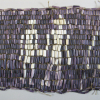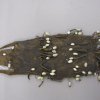Relatives/Heritage items
Displaying 1481 - 1500 of 4694 Relatives
Browsing allows you to see all the records for relatives and heritage items in the GKS. You can also search by material made, and/or filter by nations. To search by material made, type the material's name, by example 'leather', in the box below and click “Apply.” You can select multiple nations from the dropdown list by pressing “Ctrl” (on PC) or “Command” (on Mac) and clicking, then select “Apply.”
Surrender of land on the south-east side of the Detroit River. Land surrendered as a "gift", with a roadway to be built running through it. Purchased for 300 pounds Quebec currency worth of goods.
Land grant to Nancy and Mary Margaret Kerr for one pound currency.
Belt of shell wampum beads stitched in 13 rows obtained from Chief Waubuno (John P. Wampum) at Munceytown, Ontario, in 1887. Two white anthropomorphic figures stand at the centre, clasping hands, and are flanked by white diagonal lines (two on one side of the figures
Surrender of 85,000 acres in the home district of the Province of Upper Canada, situated in Peel and Halton Counties. Purchase price of 1000 pounds of goods. Certain fisheries and parcels of land have been reserved for the Indians sole use.
Sale of a tract of land on Lake Ontario including soil, woods, water and title upon receipt of 75 pounds 2 shillings 6 pence of Quebec currency in value of good
A tract of land on each side of the Grand River granted to the Six Nations as compensation for wartime losses.
Missisauga's agree to surrender a tract of land to the British for 1180 pounds currency. The nation will also allow roads to be built, as well as open navigation on rivers and lakes for the subjects of King George III.
The Saulteaux Tribe of Indians not present during the signing of Treaty No. 4 wish to adhere to all the stipulations and conditions of the treaty, as if they were present on the day of signing.
The Saulteaux, Cree, and Stonie Tribe of Indians not present during the signing of Treaty No. 4 wish to adhere to all the stipulations and conditions of the treaty, as if they were present on the day of signing.
The Saulteaux, Cree, and Stonie Tribe of Indians not present during the signing of Treaty No. 4 wish to adhere to all the stipulations and conditions of the treaty, as if they were present on the day of signing.
Five chiefs on behalf of the Chipwas nation cede to Robert Sinclair, Lt-Governor of Fort Michilimackinak, their claim to the island of Michilimackinak to the British for 5000 pounds New York Currency. The British gave a wampum belt seven feet long to the chiefs.
The Cree and Saultaux Indians agree to surrender unto the Crown a large tract of land located west of Lake Superior. Her Majesty Queen Victoria agreed to several terms which would benefit the Indians; including: hunting, fishing and trapping rights, an annual payment of money
The Metis (identified in the document as "half-breeds") of the Rainy River district requested that they be included in the terms and conditions of Treaty No. 3 between the Crown and the Salteaux Indians of Western Canada.
In consideration of one hundred and fifty-six dollars, the Crown granted unto the Honourable Alexander Campbell 1,561 acres of land located in the the Township of South Algona, in the County of Renfrew, to be held in trust for the Algonquin Band of Indians residing
The Saulteaux Tribe of Indians not present during the signing of Treaty No. 4 wish to adhere to all the stipulations and conditions of the treaty, as if they were present on the day of signing.
This object is a Victorian style pin cushion shaped like a boot. It is heavily beaded in the embossed style. A majority of the beads are clear with some multi-colored beads included in the design, particularly in the hanging loops.
The Chippewas Tribe of Indians in Western Manitoba have ceded to the Crown several tracts of land, reserving for the use of the Indian bands, various lots of land upon which they would inhabit.
Pouch of black-dyed, smoked hide, sewn to retain the form of the animal. Designed to be worn around the neck, possibly as a container for pipes and tobacco. Large beads with metal cones and a fringe add to its appearance. From the collection of the
The Chiefs and Warriors of the Chippewa and Cree Nations in consideration of an annual present or quit rent had granted unto His Majesty King George III all that land adjacent to the Red River, and Assiniboine River, extending as far as the Great Forks
Pair of twined wool garters that are elaborated with seed beads in a geometric pattern, with a porcupine quill-wrapped fringe and metal cones trimmed with red moosehair. Great Lakes origin, likely Huron-Wendat. Originally from the collection of the Bibliothèque municipale de Versailles.
 Knowledge Sharing Platform
Knowledge Sharing Platform




